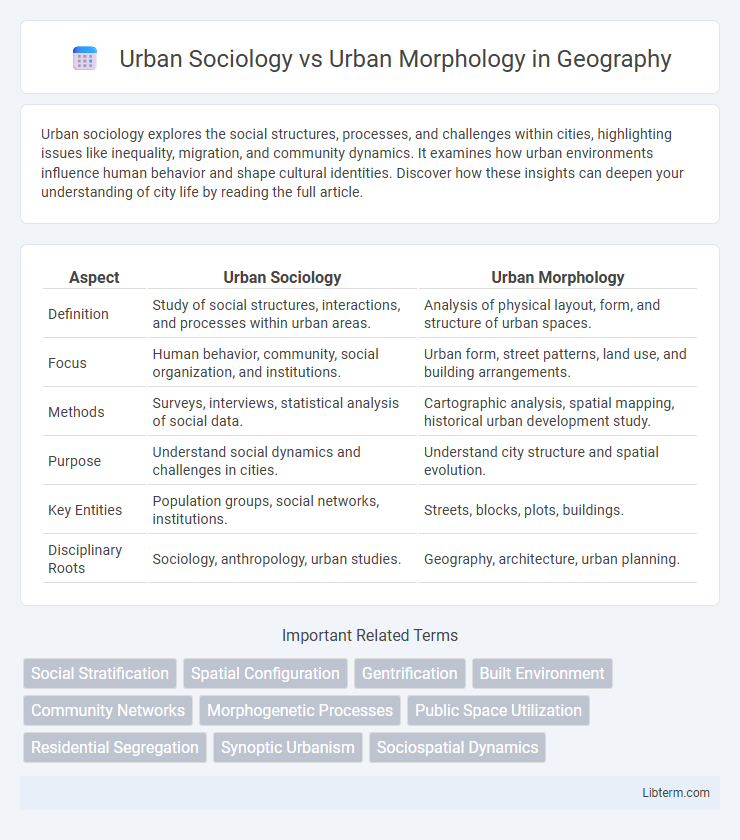Urban sociology explores the social structures, processes, and challenges within cities, highlighting issues like inequality, migration, and community dynamics. It examines how urban environments influence human behavior and shape cultural identities. Discover how these insights can deepen your understanding of city life by reading the full article.
Table of Comparison
| Aspect | Urban Sociology | Urban Morphology |
|---|---|---|
| Definition | Study of social structures, interactions, and processes within urban areas. | Analysis of physical layout, form, and structure of urban spaces. |
| Focus | Human behavior, community, social organization, and institutions. | Urban form, street patterns, land use, and building arrangements. |
| Methods | Surveys, interviews, statistical analysis of social data. | Cartographic analysis, spatial mapping, historical urban development study. |
| Purpose | Understand social dynamics and challenges in cities. | Understand city structure and spatial evolution. |
| Key Entities | Population groups, social networks, institutions. | Streets, blocks, plots, buildings. |
| Disciplinary Roots | Sociology, anthropology, urban studies. | Geography, architecture, urban planning. |
Introduction to Urban Sociology and Urban Morphology
Urban Sociology examines social structures, interactions, and behaviors within urban environments, analyzing how populations adapt to city life and the effects of urbanization on communities. Urban Morphology studies the physical form, layout, and evolution of cities, focusing on patterns of streets, buildings, and land use to understand urban development processes. Both disciplines intersect by linking social dynamics with spatial patterns to provide comprehensive insights into city life and growth.
Defining Urban Sociology: Scope and Focus
Urban Sociology examines social structures, relationships, and processes within urban environments, emphasizing population dynamics, cultural patterns, and socioeconomic factors shaping city life. It focuses on urban social issues such as migration, inequality, community organization, and urban governance. Urban Sociology's scope includes analyzing interactions among diverse groups and the impact of urbanization on human behavior and social institutions.
Understanding Urban Morphology: Key Concepts
Urban morphology examines the physical layout, structure, and form of urban spaces, analyzing elements such as street patterns, building types, and land use distribution to understand how cities evolve over time. Key concepts include the grain of the city, which refers to the size and shape of its blocks and plots, and the urban fabric, representing the interconnectedness of physical components. Understanding urban morphology provides essential insights into spatial organization, enabling planners and sociologists to interpret the relationship between built environments and social behaviors within urban settings.
Historical Evolution of Urban Sociology
Urban Sociology emerged in the late 19th and early 20th centuries, shaped by rapid industrialization and urbanization, with key figures like Chicago School pioneers Robert E. Park and Ernest W. Burgess analyzing social structures, communities, and interactions within expanding cities. This discipline focuses on the social dynamics, cultural patterns, and human behaviors in urban settings, contrasting with Urban Morphology, which examines the physical layout, design, and evolution of urban forms and landscapes. The historical evolution of Urban Sociology reveals its foundation in understanding urban problems such as poverty, segregation, and social organization amid industrial growth and demographic shifts.
The Development of Urban Morphology as a Discipline
Urban Morphology developed as a distinct discipline in the mid-20th century, emphasizing the study of the physical form, structure, and layout of urban spaces. It combines historical analysis with spatial patterns to understand how cities grow and transform over time, contrasting with Urban Sociology's focus on social behaviors and relationships within urban environments. Advanced GIS technology and interdisciplinary methods have further enhanced Urban Morphology's ability to analyze urban form and its impact on city development.
Key Theories in Urban Sociology
Urban sociology explores social structures, interactions, and processes within urban environments, emphasizing theories like the Chicago School's ecological perspective, which examines human behavior in relation to urban spatial organization. Social disorganization theory highlights how breakdowns in community control and social bonds contribute to urban problems such as crime and poverty. In contrast, urban morphology studies the physical form and layout of cities, analyzing spatial patterns, land use, and the evolution of urban structures without focusing primarily on social dynamics.
Methodological Approaches in Urban Morphology
Urban Morphology employs systematic methods such as spatial analysis, typological mapping, and historical cartography to study the physical layout and structural form of urban areas. Quantitative techniques, including Geographic Information Systems (GIS) and morphogenetic models, are extensively utilized to analyze patterns of street networks, building footprints, and land use distribution. This approach contrasts with Urban Sociology's qualitative emphasis on social interactions and community dynamics within urban spaces.
Comparative Analysis: Social Patterns vs Physical Structures
Urban Sociology examines social patterns, interactions, and community behaviors within city environments, emphasizing issues like socioeconomic status, migration, and inequality. Urban Morphology analyzes the physical structures of cities, focusing on spatial layout, building forms, and infrastructure development to understand urban growth and transformation. Comparing these fields highlights how social dynamics influence urban design and how physical environments shape social behavior, revealing the interdependence between societal trends and urban form.
Practical Applications: Urban Planning and Policy Impacts
Urban Sociology provides insights into social behavior, community dynamics, and population trends, which guide inclusive urban planning strategies and social policy development. Urban Morphology analyzes the physical layout and structural elements of cities, informing zoning regulations, infrastructure design, and spatial organization for efficient land use. Integrating both disciplines enhances urban planning outcomes by addressing social needs alongside spatial form, shaping sustainable and resilient urban environments.
Future Directions in Urban Sociology and Urban Morphology
Future directions in urban sociology emphasize integrating advanced data analytics and participatory research to understand social dynamics in rapidly evolving cities, focusing on issues like inequality, migration, and community resilience. Urban morphology is progressing towards incorporating smart city technologies and spatial data science to analyze urban form transformations and sustainability patterns. Cross-disciplinary approaches combining sociological insights with morphological analysis aim to create holistic frameworks for sustainable urban development and policy-making.
Urban Sociology Infographic

 libterm.com
libterm.com